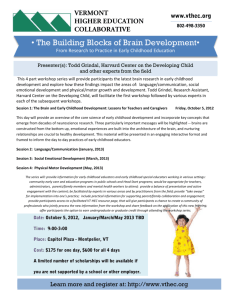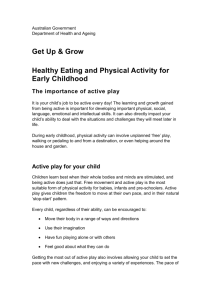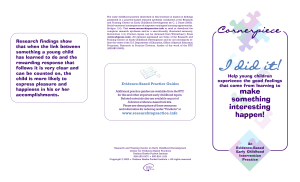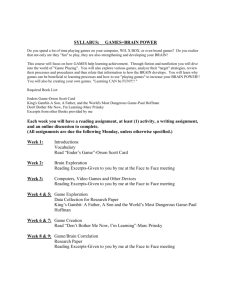Document 10465981
advertisement
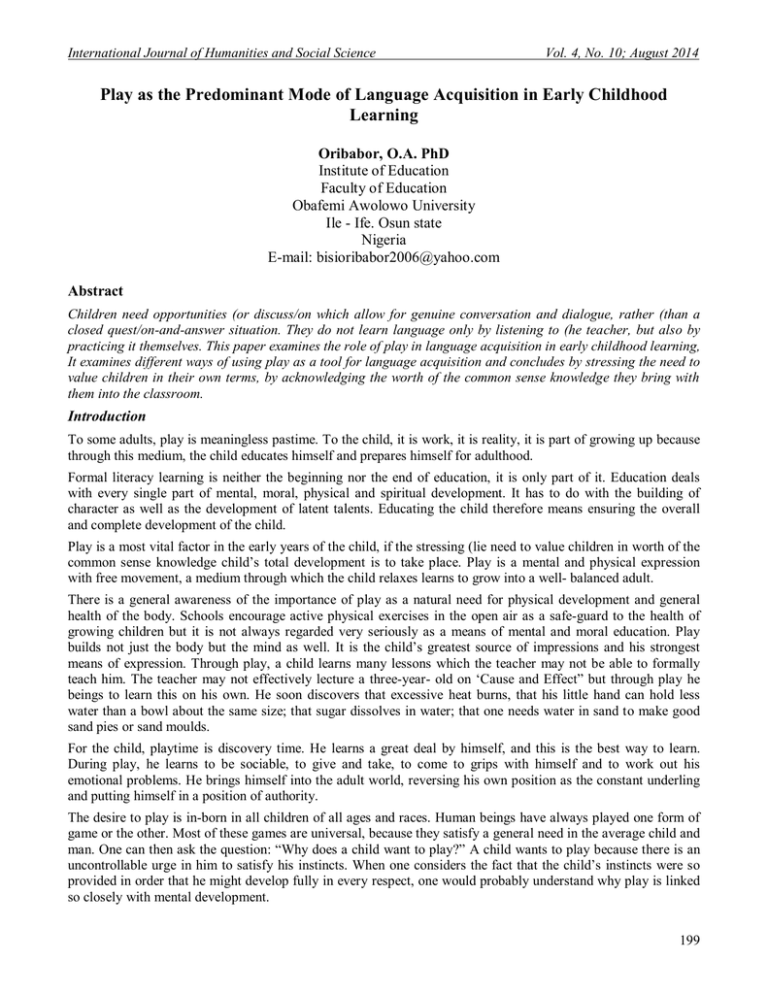
International Journal of Humanities and Social Science Vol. 4, No. 10; August 2014 Play as the Predominant Mode of Language Acquisition in Early Childhood Learning Oribabor, O.A. PhD Institute of Education Faculty of Education Obafemi Awolowo University Ile - Ife. Osun state Nigeria E-mail: bisioribabor2006@yahoo.com Abstract Children need opportunities (or discuss/on which allow for genuine conversation and dialogue, rather (than a closed quest/on-and-answer situation. They do not learn language only by listening to (he teacher, but also by practicing it themselves. This paper examines the role of play in language acquisition in early childhood learning, It examines different ways of using play as a tool for language acquisition and concludes by stressing the need to value children in their own terms, by acknowledging the worth of the common sense knowledge they bring with them into the classroom. Introduction To some adults, play is meaningless pastime. To the child, it is work, it is reality, it is part of growing up because through this medium, the child educates himself and prepares himself for adulthood. Formal literacy learning is neither the beginning nor the end of education, it is only part of it. Education deals with every single part of mental, moral, physical and spiritual development. It has to do with the building of character as well as the development of latent talents. Educating the child therefore means ensuring the overall and complete development of the child. Play is a most vital factor in the early years of the child, if the stressing (lie need to value children in worth of the common sense knowledge child’s total development is to take place. Play is a mental and physical expression with free movement, a medium through which the child relaxes learns to grow into a well- balanced adult. There is a general awareness of the importance of play as a natural need for physical development and general health of the body. Schools encourage active physical exercises in the open air as a safe-guard to the health of growing children but it is not always regarded very seriously as a means of mental and moral education. Play builds not just the body but the mind as well. It is the child’s greatest source of impressions and his strongest means of expression. Through play, a child learns many lessons which the teacher may not be able to formally teach him. The teacher may not effectively lecture a three-year- old on ‘Cause and Effect” but through play he beings to learn this on his own. He soon discovers that excessive heat burns, that his little hand can hold less water than a bowl about the same size; that sugar dissolves in water; that one needs water in sand to make good sand pies or sand moulds. For the child, playtime is discovery time. He learns a great deal by himself, and this is the best way to learn. During play, he learns to be sociable, to give and take, to come to grips with himself and to work out his emotional problems. He brings himself into the adult world, reversing his own position as the constant underling and putting himself in a position of authority. The desire to play is in-born in all children of all ages and races. Human beings have always played one form of game or the other. Most of these games are universal, because they satisfy a general need in the average child and man. One can then ask the question: “Why does a child want to play?” A child wants to play because there is an uncontrollable urge in him to satisfy his instincts. When one considers the fact that the child’s instincts were so provided in order that he might develop fully in every respect, one would probably understand why play is linked so closely with mental development. 199 © Center for Promoting Ideas, USA www.ijhssnet.com There are different ways by which the teacher can made use of play in early childhood education, Through the use of games, the teacher can assist the child to discover, explore and adapt to the environment. It is pertinent to examine the various ways by which children can be taught through play. Use of Games When children play, they are either at a game of physical and mental activity or other types of occupation wherein they construct, create, investigate, explore, imitate or engage in various other forms of physical and mental exercise. Games constitute one form of play, although other types of play could be incorporated in any one game. One of the most universal and oldest games is “Hide and Seek”. This may have originated from the time when the cavemen had to track down animals. It is a game that has taken on other variations such as “Treasure Hunt”. Much of the child’s play during these years is concerned with the external manipulation of symbols which are heavily impregnated with his feelings about his social environment and his relationship to it. This activity is of great importance for his emotional and social development. It should be noted that the mechanism for the expression of his feelings derives from the symbolic mode of thinking he is employing at this time. There is need to stress the valuable role of play groups, day nurseries and nursery schools in aiding the socialization of children from socially deprived families. Few local authorities are known to run play groups, although some grant aid to voluntary ones. There are many activities in which children engage, such as learning to play the piano, which are tedious, laborious, and even painful. Others, such as playing ball, are fun, unrestrained, and carefree for most children. Both may be characterized by active involvement with materials, but they have considerable differences. One appears from the adult point of view to be work and the other play. How, if at all, do open educators account for these differences? Most would admit that there are vast differences in the nature of activities in which children become involved, but that rewards come from participating in and completing the activity and are not dependent on the ease of the activity. Hence, the labour in learning to play a musical instrument may well be greater than that of playing ball, but so may be the reward. Otherwise, the child would be playing ball, not playing the piano. One of the problems open educators have had in trying to distinguish between work and play or in trying to eliminate the distinction is that they have not been able to separate the adult’s view of what the child does from the child’s view. Young children are not conscious of a work-play distinction, but become increasingly aware of one as they go through the grades. It appears to be an adult artifact as many adults tend to assume that any task that is productive for children in school must be difficult and often painful. If it hurts, there must be something beneficial about it. Conversely, it has been assumed that things that are fun and pleasurable are unproductive and usually take place in ‘free time” or out of school. The child has a different perception of play from that of adults. It would seem that early childhood educators have some obligations to narrow the gap between what children consider as pleasurable activities and academic endeavours. Play as a Tool for Discovery Children can respond to courteous treatment by adults, and that to a great extent they can be trained to take the initiative in learning, if choices are real and if a rich variety of material is offered them. The best materials are ambiguous; they can be used for many purposes. By choosing their own uses of the material offered, children learn on their own terms. The understanding of a subject, the grasp of its structure, comes through self-directed activities of the child. Children learn most effectively if they choose what to do from amongst a range of activities. Central to early childhood education is the question of agency. Who or what will direct the child’s explorations and play? What will be the origin of the problems and materials in which he is engaged? Many early childhood educators eschew any attempt whatsoever to control or manipulate children’s behaviour. However, in the act of selecting materials for the classroom, the adult does in fact exercise a large measure of control over the direction of the child’s learning and exploration. Ideas and concepts emerge out of activity with materials. Control of materials, then, implies control of experience, which in turn implies control of ideas and concepts. 200 International Journal of Humanities and Social Science Vol. 4, No. 10; August 2014 By bringing books into the classroom the teacher makes it more likely that children will want to learn how to read. If there were not written words available perhaps they would not. By bringing a telescope into the classroom the teacher increases the likelihood that children will become interested in the stars and planets. If teachers really wish to free children from all adult controls they may have to let children bring all materials into the classroom themselves. They also may have to abandon the institution of school altogether. It is doubtful that even these measures would eliminate adult control of children’s activities. At the same time it is questionable whether complete removal of adult control is desirable. Most children do not have access to a wide range of materials which they might want to explore, nor do they have the time and place that would permit such exploration. Effective teaching with children in the classroom would seem to depend not on the abdication of adult control to children, but on a deliberate and conscious sharing of responsibility for learning on the part of child and teacher. The adult, to a large extent, determines the nature of the school environment; the child decides with which of these materials he will work, to which problems he will address himself, for how long and with whom. Since the materials for children’s learning are so important, criteria for their selection are crucial. The teacher in the open school favours materials that are likely to initiate and sustain interest, exploration, and learning. For five year-olds he might choose a set of blocks rather than a deck of cards, or a picture book rather than a dictionary. Exploratory behavior dominates only in the absence of the more urgent needs. Children can think and form concepts, as long as they work at their own level, and are not made to feel that they are failures. Play as a Tool for Exploration At every stage of learning, children need rich and varied materials. Children are not taught to think, they are given something to think about. When using any material for the first time, the child will experiment with it, exploring its possibilities. The interest in things is a perfectly real, perfectly independent and autonomous interest, which is there just as genuinely as the interest in persons is there in young children. And some children are only able to develop intellectually by first coming to grips in an exploratory and involved way with the inanimate world. The child must discover for himself in his own time. He will do this if the relevant material is available to him in sufficient quantity and variety, if he is given many opportunities of handling it and trying it out. In play, children gradually develop concepts of causal relationships, the power to discriminate, to make judgements, to analyse and synthesize, to imagine and formulate. Children’s learning does not occur in a vacuum. Children play with something or someone; they do not just play. Exploratory behaviour is of little consequence unless there is something to explore. Play as a Tool for Social Adaptation The essential instrument of social adaptation is language, which is not invented by the child but transmitted to him in ready-made, compulsory, and collective forms. These are not suited to expressing the child’s needs or his living experience of himself. The child, therefore, needs a means of self- expression, that is, a system of signifiers constructed by him and capable of being bent to his wishes. In a child’s world, for example, the sun and moon follow him as he is walking along; dreams fly in through the window; everything that moves is alive. Unless the teacher is able to talk to the child seriously at his own level, no appropriate discourse will develop during which he can confront a child, when he is ready, with the illogicalities of his own thought, thus creating cognitive conflict and preparing the way for the child to pass on to the next stage. As Richards (1973) points out, discovery learning need not always be at a concrete level as it is for younger children. Adolescents discover 100,1 but symbolically through the use of language, by exploring hypotheses either alone or in cooperation with their peers. Wittgenstein (1953) suggests that children learn to use language by participating in ‘language games’ and that they learn these rules by playing games. And before a child starts using words himself, he has had plenty of language preparation. He has handled objects, heard an adult refer to them by name, and can recognize them. It is only when a child uses language to denote objects in the same way as adults that we can even suspect that he shares the same concepts. Yet to use words correctly as labels does not necessarily mean that the child fully understands the Underlying concepts. 201 © Center for Promoting Ideas, USA www.ijhssnet.com Jones (2001) shows how six-year-olds use geographical terms like ‘town’, city’, ‘capital’ correctly in some contexts (for example ‘London is the capital of England’), but in other contexts reveal incomplete understanding. Learning to play language games is then a continuous process, and indeed a social process. To make themselves intelligible children must learn the public rules governing the use of words. Without these rules, which are of course not explicitly taught, there would be no common understanding language as we know it. This notion of public rules governing language is clearly appl learning of practical Children learn the uses of concepts not only by adults using them, but about them themselves. Language has gone beyond the mere labeling stage. They might learn the use of spoon by observation, but it would be difficult to learn the use of a post office or a bank merely by observing what people are doing in them. Without language none of the activities that go on in these places would make any sense at all, so that the concepts cold never evolve. One of the most unfettered and therefore least threatening occasions when creativity can begin to develop in young children is when they are at play. Although we cannot teach children to be creative, we can provide conditions in which creative abilities can develop, by ensuring that teaching like play, does not stifle children’s imagination by its rigidity and inflexibility. Conclusion From the foregoing, there is the need for teachers to think of practical steps to be taken to create a school climate favourable to the development of creative thinking and abilities in children. Torrance (1967) makes proposals that anticipate just those attitudes being advocated by Esland (1971) and others within a phenomenological framework in the sociology of education. Torrance’s suggestions are that teachers should be respectful of children’s unusual questions and ideas, showing them that these ideas have value. They should provide opportunities for selfinitiated learning and for periods of non-evaluated practice, indicating that whatever children do may be of some value and is not constantly going to be assessed by some absolute criterion of correctness set up by teachers. This emphasizes not only the need to value children in their own terms, by acknowledging the worth of the common sense knowledge they bring with them into the classroom, but also acknowledges the importance of freedom and flexibility to develop and grow. These are not only the cornerstones of both cognitive and creative development but also part of what is meant by education. Conclusion Language, by its very nature is a social process. Although it seems highly plausible that humans have an inbuilt ability to learn language rapidly, and others suggests, nothing resembling human speech would be developed if children were not brought up in a social world where people communicate with others by linguistic means. The main purpose of this paper was to help teachers make an appraisal of young children’s skill in using language, as they listened to them talking, talked with them, and helped them to explore their ideas and experiences. References Esland, G.N. (1971). Teaching and Learning as the Organisation of Knowledge in Young, N.E. New York: Collier Macmillan. Jones, J. (2001): Social Class and the Under 5’s. London: University of London Press. Richard, C. (1973). Third Thoughts on Discovery, Educational Review, 55, 27. Torirance, E.P. (1967). Give the Devil His Dues in Gowan, J.C.et. al. (eds): Creativity: Its Educational Implications. New York: Wiley. Vigostsky, L. (1962): Thought and Language, Cambridge, Mass, M.I.T. Press. Wittgenstein, L. (1953). Philosophical Investigations, Oxford: Blackwell.. 202

